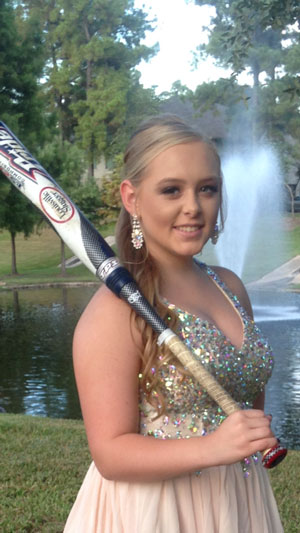
Determined to find the best care for her daughter, MaKayla’s mother, Tracy, did her homework, researching physicians online and asking friends for referrals. Her search led her to Lindsay Crawford, MD, a pediatric surgeon affiliated with Children’s Memorial Hermann Hospital and assistant professor in the Department of Orthopedic Surgery at McGovern Medical School at UTHealth.
MaKayla’s family knew right away they had made the right choice. “All of Dr. Crawford’s reviews were high, and I took comfort in the fact that she teaches. She took the time to educate us and was always very up front about everything, answering all of our questions,” says Tracy. “She was great from day one.”
Starting Treatment
Dr. Crawford examined MaKayla’s back, noting asymmetry in her shoulder blades and in her shoulders, and ordered an X-ray of MaKayla’s spine, which showed that her upper spine was curved at a 44-degree angle. The diagnosis: adolescent idiopathic scoliosis, or AIS. “Idiopathic” means “of unknown cause.” According to the Scoliosis Research Society, over 80% of scoliosis cases fall into this category.
Scoliosis is a musculoskeletal disorder characterized by side-to-side curvature of the spine. On an X-ray, those curves resemble an “S” or “C,” rather than a straight line. According to the Scoliosis Research Society, AIS affects 4 in 100 adolescents, and commonly develops between ages 10 and 14, more often in females.
Dr. Crawford explained to MaKayla’s family that the severity and treatment of AIS depends upon the degree of curvature in the patient’s spine. A child with a curvature of 10 to 15 degrees will typically need regular checkups until he or she has reached puberty and finished growing. A child with a curvature of 20 to 40 degrees will typically be fitted with a back brace, to halt or slow progression of the curve. And a curvature of 45 to 50 degrees typically requires surgical treatment, to straighten the spine.
Scheduled for Surgery
By February 2016, the curve in MaKayla’s spine had increased to 47 degrees. Dr. Crawford recommended surgical treatment to straighten MaKayla’s spine and prevent her condition from worsening. She suggested scheduling the surgery for the summer, when MaKayla would be out of school and would have ample time to rest and heal. By April, MaKayla’s curve had increased to 51 degrees.
In May, MaKayla and her family met with Dr. Crawford and members of the extended team, to ask questions and to mentally prepare. Recalls Tracy, “They walked us through what to expect, starting from the time we arrived at the valet. We toured the hospital and met with a Child Life Specialist. Seeing everything up front helped ease MaKayla’s anxiety.”
Headed Back to the Field
On June 20, which Tracy describes as a “very, very long day,” Dr. Crawford and her team, including affiliated pediatric surgeon Shiraz Younas, MD, performed the procedure at Children’s Memorial Hermann Hospital, inserting two rods into MaKayla’s upper back to straighten her spine and fusing 11 of her vertebrae. The surgery went well, and MaKayla was up and walking the next day. After five days, she was released to go home.
“The hospital and the staff were amazing,” says Tracy. “MaKayla was in great pain (from an unrelated stomach issue), and the nurses were so incredibly gentle and patient with her. Patience is a God-given talent, and they have found that talent.”
After three weeks, MaKayla began to feel more like herself. And by September, she was cleared to resume softball, her passion. Given the fusion in MaKayla’s spine, she has had to learn a new swing, Tracy says. But scoliosis has definitely not taken her out of the game.